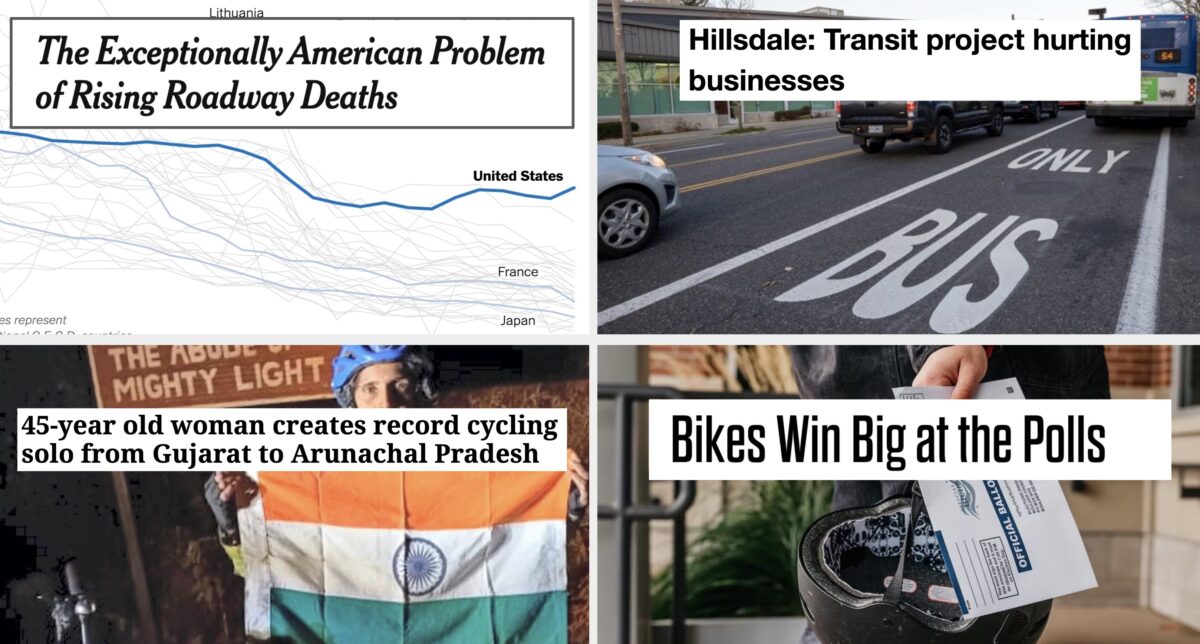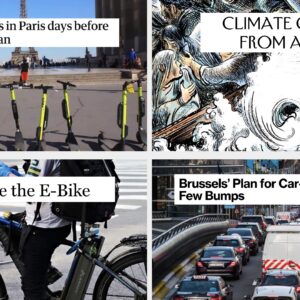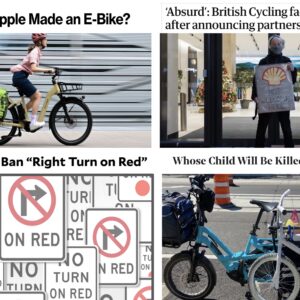Use code bikeportland22 and save 20% off at ShowersPass.com!
Welcome to the week. We hope you had a nice holiday.
This week’s Monday Roundup is made possible by Showers Pass, makers of quality waterproof rainwear and gear that’s proudly designed and tested right here in Portland!
Here are the most notable stories our writers and readers came across in the past seven days…
Who’s the victim?: You know we live in a dysfunctional, car-soaked culture when a magazine decides to publish a sympathetic profile of a woman whose reckless driving killed two innocent people — and of course it comes out just before her trial starts. (LA Magazine)
Blame the buses: A story about a bus lane project in Hillsdale features only complaints from business owners and drivers who say the lack of car access is too much to bear. (Portland Tribune)
Bike the vote: The recent election included around $3.6 billion in successful funding measures nationwide that could lead to bicycling infrastructure. (People for Bikes)
Same ol’ same ol’: America’s roads and transportation system is exceptionally deadly and dysfunctional, and until we end car abuse and its enablers nothing will change. (NY Times)
Record ride: A 45-year-old woman broke the record for longest solo bike ride when she conquered headwinds and freezing temperatures to tally nearly 4,000 km of pedaling across India. (The Indian Express)
Bike lanes and the ADA: Disability rights orgs have filed suit in Washington DC over what they say are bike lane projects that run afoul of the Americans with Disabilities law. (WTOP)
Video of the Week: Don’t miss Amit Zinman’s video recap of last week’s World Day of Remembrance for Roadway Traffic Victims event:
Thanks to everyone who shared links this week.








Thanks for reading.
BikePortland has served this community with independent community journalism since 2005. We rely on subscriptions from readers like you to survive. Your financial support is vital in keeping this valuable resource alive and well.
Please subscribe today to strengthen and expand our work.
Looking at the street design in DC on 17th, it actually looks like a really bad design, but of course its designed with a ‘car-first’ approach. Reading the initial article I just assumed that DC removed parking all together, but they haven’t, the street looks like a parking lot on google street view.
The obvious remedy is to remove general parking from one side of the street and turn it into dedicated ADA spots and one loading zone per block, but I doubt that the NIMBY association behind this action will agree. I kind of doubt they care about the ADA angle at all.
I don’t see why people with disabilities would be more at risk of getting hit by a cyclist than a motorist generally, but I also hate parking”protected” bike lanes so I’m interested to see where it goes.
https://dccil.org/
I guess disability advocay orgs are the new “NIMBYs”
Why would low-income people, black people, people with “disabilities”, and other marginalized demographics be skeptical about white lanes – erm – bike lanes?
https://www.dcpolicycenter.org/publications/the-demographics-of-walking-and-biking-to-work/
And when it comes to the demographics that bike, Portland is definitely becoming more like DC.
You’re going off the deep end here, buddy.
If it’s going off the deep end to point out that people who bike in DC are more likely to be higher-income and white then so be it. I think bus users, pedestrians, disabled people, and “people who cycle” are natural allies so perhaps an intersectional approach to transportation advocacy would be a good idea in DC (and Portland).
This argument is really silly. It’s really just putting an equity lens on the whole ‘why should we build bike/pedestrian/public transit infrastructure, everyone wants to drive’.
You’ve gone so far to the left that you’ve met up with right-wing car advocates. Well done!
The political spectrum is more like a circle sometimes. We saw this during the Covid era, with a lot of people on both extremes finding common ground.
That’s a great article. I don’t understand the criticism you’re getting about this comment.
I think it’s simple: people can’t fathom seeing data that doesn’t agree with their (wrong) assumptions. I find the starts Soren’s article presents quite illuminating.
It’s kind of unreal that pointing out how socioeconomic and racial disparities may lead to skepticism and, even, misunderstanding when it comes to cycling infrastructure is characterized as “you’ve met up with right-wing car advocates”. (There was no mention of “cars” in my comment.)
soren, go back and re-read your comment. What you’ve said in this comment doesn’t appear in your original comment.
I don’t mean to speak for him, but soren’s new comment looks to me like a very accurate paraphrasing of his original comment. He wrote,
It’s kind of unreal that pointing out how socioeconomic (vs. original comment’s “low-income people”) and racial disparities (vs. original’s. “black people”) , and other marginalized demographics (vs. original’s “people with “disabilities” “) may lead to skepticism (vs. original’s identical “skepticism”) and, even, misunderstanding when it comes to cycling infrastructure (vs. original’s “bike lanes”) is characterized as “you’ve met up with right-wing car advocates”.
But it does. I think there is a fair bit of motivated thinking when it comes to cycling advocacy and, unfortunately, the facts don’t always support this internalized narrative.
If it’s the driver who’s disabled, switching to protected bike lanes means they’re now getting in and out in a traffic lane instead of a bike lane, so it’s less safe.
If it’s a passenger who’s disabled, it means they’re now getting out in a bike lane instead of onto the sidewalk, which is also less safe.
My experience is that people who design buildings and infrastructure often don’t design to meet ADA standards. And they rarely go beyond meeting the standards to create designs that work well for people with disabilities. The new Earl Blumenauer bridge is a perfect example. So the lawsuit doesn’t surprise me.
“sympathetic profile”
It didn’t seem too sympathetic to me. More like a gossip column about a person in the news.
I drove through “beautiful” Hillsdale the other day, managed to stay in the correct lane. BFD! The bellyaching from Hillsdale, Multnomah, and SW in general on land use and transportation issues becomes tiring. Said by a local boy…Multnomah School class of 1960.
What’s not beautiful about an urban village that is at least 50% parking spaces?
For real! Maybe people aren’t buying as much stuff because of the myriad or other factors, like cost of living increases. Do these business owners really think that people are avoiding their stores because there’s a bus lane there now? Like who is driving 55mph on a stroad and stopping at businesses in strip malls because they look interesting?
Should we add “mentioning mode of transportation to business owners” as an advocacy tool? Like, “wow, love how many bike racks your restaurant has” or “Great stuff in the store but it’s a bit hard to access on foot due to x”.
“Do these business owners really think that people are avoiding their stores because there’s a bus lane there now?”
Yes, clearly they do. They’ve noted a concerning (to them) correlation, and have concluded that it is more likely that the reduction in auto access is causing their fall in sales rather than the other way around. And they may be right.
I totally get that some of you don’t care about some small boutique failing (I really don’t either, to be honest — my tribe doesn’t do boutiques, and can’t make an omelette without breaking eggs, right?), but people talk and this stuff gets around, so if PBOT puts a bunch of small businesses out of business, it’s going to make the next business district fight that much harder when PBOT comes to town.
So maybe let’s hope PBOT doesn’t totally screw up their response.
The thing about this area is you pretty much have to go through Hillsdale to get to a large portion of SW (hence why several bus lines go through the area). So people are either going at a different time, sitting in more traffic, or used a different mode of transportation.
This type of business response seems to happen anytime driving or parking capacity is affected. Even in the most walkable parts of the city, businesses will still complain (see Ovation Coffee in the Pearl). Hillsdale response is not unique and I imagine not the last time we will hear how bike and bus transportation destroys businesses.
Honestly, if people are really so upset about this change, they could just drive in the Rose Lane to bypass the traffic. Cops don’t enforce traffic infractions in this city, so the odds of getting caught are essentially zero.
I am a regular customer at Hillsdale Town Center. I arrive from the west by car, and I have a completely different opinion about the rose lanes from the business owners in the Tribune piece.
I like the rose lanes, they make it easier to pull into the shopping center. Why? Because the right lane no longer has through traffic barreling along, on your tail, as you try to slow down to make a right turn into the parking lot. No more right turns while staring into my rearview mirror!
Moreover, the last time I was there I had trouble finding a place to park! God honest, I really did think “wow, we’re back to pre-pandemic shopping levels.” And the wait at Gigi’s—10 to 15 minutes to get a table.
I read Redden’s piece twice, and it doesn’t seem that he actually visited the site. It’s all just quotes from the business owners. If he had stopped by he might have found a full parking lot.
“It’s all just quotes from the business owners.”
Why would the business owners be upset if there’s tons of customers around?
Hopefully, PBOT is collecting data that they can show to counter the narrative that the bus lanes are causing a problem.
Hi Watts, the same business owners were upset in anticipation of the rose lanes. My experience is that any change viewed as encroaching on car dominance is met with a negative reaction by some people.
The restaurants have lines out the doors. Paloma’s was crowded the day I stopped by … My point with the reporting is that it is always best to stop by and check things out yourself. How long do you have to stand in line for a cup of coffee?
You nailed it, Lisa. Unlike the commenters here, I live on the 44 and 45 lines PAST Hillsdale and I’m a regular bus rider. I’ve noticed a *fantastic* improvement in the bus-transit times thru Hillsdale, especially coming from downtown. And I agree that the right-turn into the parking lots is so much easier than it used to be. Cycling is nicer too, b/c cars aren’t crowding the bike lanes anymore.
The people who are complaining about their driving times might consider (drum roll) taking the bus?? You can do it – it’s a bit more trouble but you can do it. Take one for the team and stop prioritizing your own convenience.
Your comment makes me think–if the complaint is impacts on businesses, the comprehensive impact should be looked at, not just the impact on the Hillsdale ones the bus goes past.
Your experience is it improves your bus ride from downtown. Improved bus service to and/or from downtown is a benefit for downtown businesses. They’ve been begging for support from the City, and the City has responded by improving bus service to them from SW.
Even if it’s true that the change harms customer access to Hillsdale businesses (I’m not saying it is) it’s almost certainly true it helps downtown businesses. Any article about impacts to businesses should mention that .
The business owners cite a decline in same month sales compared to the previous year. Despite the assertion of the store proprietors that were interviewed, it may not be possible to draw a clear connection between sale volumes and the road configuration. The economic climate is very different this year than it was last year. I think the owners are looking for a scapegoat to blame instead of considering that we are likely at the start of a recession.
Last fall, the federal government was still giving out monthly child tax credits, many people still likely had stimulus money in the bank, the housing market was booming, interest rates were low, and the stock market was up.
All of these things have changed, and I keep reading news stories about national retailers offering pricing incentives to lure back consumers, who are no longer spending freely. Don’t blame the road. It’s the economy, stupid*.
*Quoting James Carville, not trying to suggest the store owners are unintelligent.
It’s quite possible you’re right, which is why we need PBOT to collect data to counter the obvious (but possibly wrong) narrative and avoid poisoning future efforts.
PBOT *is* collecting data, and has repeatedly said they would.
I was thinking the same thing, Boyrd – correlation is not causation. The only thing you can really measure here is car traffic – the actual effect the changes have on traffic. And even then you can’t draw a one-for-one inference between car traffic and sales. As you pointed out, sales are affected by MANY other factors (like money – duh), not just by how many cars are driving into a parking lot.
The NYTimes article about the deadly nature of our infrastructure is actually a huge shift in tone in a positive direction. Previous coverage of the rising traffic fatalities blamed “reckless drivers” like most other major news outlets. Charles Marohn of Strong Towns called that rhetoric out for being wrong – traffic was slowing down cars making it safer on these roads and streets. It wasn’t enraged drivers from the pandemic throwing caution to the wind, but drivers deciding to go the speed that the asphalt was designed to support. Any blame we rightfully assign to drivers should also be assigned to the infrastructure that prioritizes throughput over safety at every chance.
I was coming into the comments to highlight the nytimes article as well. Emily Badger is fantastic, so I wasn’t surprised to see she was part of it. The title is strong: “The Exceptionally American Problem of Rising Roadway Deaths”
I’m in a fancy exurb of Phoenix right now. I was walking (gasp), the intersection had five lanes going onto the main street: three left turn lanes, one straight ahead, one right turn.
At another intersection, in a car, I made the mistake of stopping for a yellow light instead of turning left. A truck behind me swerved into the oncoming lanes to make the left on a red. I’m sure he was headed to perform an important operation at the hospital, his time was clearly very valuable.
I lived in San Diego and Los Angeles, I’m not unaware of car oriented architecture. This is just to another level.
I have certainly seen people in foot and on bike here. There’s a much stronger class component to it- clearly the only reason to not be in a car is not being able to afford it.
Back to NYTimes, it’s amazing how we still see bias in “crash reporting”. PPB is very willing to mention the victim was wearing dark clothes, or suddenly veered into the “traffic lane”, as if they aren’t traffic while walking or on bike. And the social network devoted to neighborhood NIMBYs is always ready to comment about how pedestrians suddenly leap into traffic instead of going to the nearest striped crosswalk, and ultimately it’s their fault, because they are “dead right”.
NYTimes notes that fatalities increased even with less traffic (I thought we were blaming frustrated drivers, now it’s.. not enough traffic?) during covid. It reminds me of how people blame very good pavement, or speed bumps, or potholes, as being sources of unsafe driving.
This isn’t just at the fringe of the Overton Window, it’s a fairly drastic societal shift that needs to take place to remove vehicles (and drivers) from the top of the food chain. This isn’t just a “Netherlands+France vs the world” situation, somehow we are a massive outlier. It isn’t an enforcement (police) issue. It isn’t a road quality issue. It’s the priority our society gives to them.
I’m a car owner and driver, a bus rider, a utility cyclist and Fred-style spandex cyclist. I don’t have any answers. But it’s a fallacy to dismiss the problem just because I don’t have the answer, or because I’m not willing to spend all my free time to volunteer to do PBOT’s job (hi Better Naito, hi Powell Blvd overpass cleaners, hi BikeLoud, you are all doing amazing work!).
My point is we have a problem.